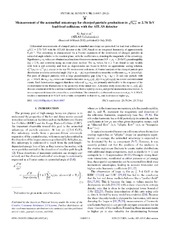Measurement of the azimuthal anisotropy for charged particle production in \(\sqrt{s_{NN}}\) = 2.76 TeV lead-lead collisions with the ATLAS detector
Aad, Georges; Abbott, Brad; Abdallah, Jalal; Abdel Khalek, Samah; Abdelalim, Ahmed Ali; Abdesselam, Abdel; Abdinov, Ovsat Bahram oglu; Abi, Babak; Abolins, Maris; AbouZeid, Hass; Buanes, Trygve; Burgess, Thomas; Eigen, Gerald; Johansen, Lars Gimmestad; Kastanas, Alex; Liebig, Wolfgang; Lipniacka, Anna; Rosendahl, Peter Lundgaard; Sandaker, Heidi; Sjursen, Therese B.; Stugu, Bjarne; Tonoyan, Arshak; Ugland, Maren; Bugge, Lars; Buran, Torleiv; Cameron, David Gordon; Czyczula, Zofia; Gjelsten, Børge Kile; Lund, Esben; Ould-Saada, Farid; Pajchel, Katarina; Pylypchenko, Yuriy; Read, Alexander Lincoln; Røhne, Ole Myren; Samset, Bjørn Hallvard; Stapnes, Steinar; Strandlie, Are; Abramowicz, Halina; Acerbi, Emilio; Adamczyk, Leszek; Adams, David; Addy, Tetteh N.; Adelman, Jareed; Adomeit, Stefanie; Adragna, Paolo; Adye, Tim; Aefsky, Scott Alan; Aguilar Saavedra, Juan Antonio; Aharrouche, Mohamed; Ahlen, Steven; ATLAS, Collaboration
Peer reviewed, Journal article
Published version
Permanent lenke
https://hdl.handle.net/1956/10493Utgivelsesdato
2012-07-24Metadata
Vis full innførselSamlinger
Originalversjon
https://doi.org/10.1103/physrevc.86.014907Sammendrag
Differential measurements of charged particle azimuthal anisotropy are presented for lead-lead collisions at \(\sqrt{s_{NN}}\) = 2.76 TeV with the ATLAS detector at the LHC, based on an integrated luminosity of approximately 8 \(\mu b^{-1}\). This anisotropy is characterized via a Fourier expansion of the distribution of charged particles in azimuthal angle \(\phi\) , with the coefficients \(v_n\) denoting the magnitude of the anisotropy. Significant \(v_2-v_6\) values are obtained as a function of transverse momentum (0.5<pT<20 GeV), pseudorapidity (|\).eta\).<2.5) and centrality using an event plane method. The \(v_n\) values for \(n\ge3\) are found to vary weakly with both \(\eta\) and centrality, and their pT dependencies are found to follow an approximate scaling relation, \(v_n^{1/n}(pT) \propto v_2^{1/2}(pT)\). A Fourier analysis of the charged particle pair distribution in relative azimuthal angle \((\Delta\phi=\phi_a-\phi_b)\) is performed to extract the coefficients \(v_{n,n}=<cos (n \Delta\phi)>\). For pairs of charged particles with a large pseudorapidity gap \((|\Delta\eta=\eta_a-\eta_b|>2)\) and one particle with pT<3 GeV, the \(v_{2,2}-v_{6,6}\) values are found to factorize as \(v_{n,n}(pT^a,pT^b) \sim v_n(pT^a)v_n(pT^b)\) in central and mid-central events. Such factorization suggests that these values of \(v_{2,2}-v_{6,6}\) are primarily due to the response of the created matter to the fluctuations in the geometry of the initial state. A detailed study shows that the \(v_{1,1}(pT^a,pT^b)\) data are consistent with the combined contributions from a rapidity-even \(v_1\) and global momentum conservation. A two-component fit is used to extract the \(v_1\) contribution. The extracted \(v_1\) is observed to cross zero at \(pT\sim\) 1.0 GeV, reaches a maximum at 4-5 GeV with a value comparable to that for \(v_3\). and decreases at higher pT.

